Medion Akoya E3211 – 13.3in CULV Laptop Review
Medion Akoya E3211 – 13.3in CULV Laptop
Unlike most similar CULV laptops, the Medion E3211 has an optical drive, but is this enough to warrant a purchase?
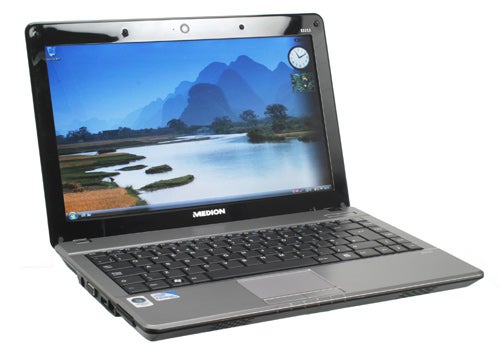
Verdict
Key Specifications
- Review Price: £499.99
Anyone who has popped into a Aldi store will know the name Medion. This German-based PC manufacturer is renowned for its affordable, high-spec laptops and PCs, particularly ones sold at ridiculous knock-down prices in said retailer. Today we’re looking at the Medion Akoya E3211, a 13.3in laptop that’s one of the company’s entrants into the burgeoning Intel CULV segment.
One thing that separates the E3211 from similar offerings such as the Acer TravelMate Timeline 8371 is the presence of an optical drive. Typically, in this part of the market at least, optical drives are only found in 14in models like the Acer 4810T or equivalents. Having an optical drive does mean the Medion isn’t as svelte as competing offerings, weighing 1.7kg and measuring 31.5mm thick, but if you do use optical media regularly but find a 14in laptop too large then this could be the option for you.
At £499.99 from Medion’s own online store, it’s a very cheap option, too. This affordability is reflected in the design and build quality, though. While the glossy black lid and plain silver body are inoffensive, they lend the E3211 an exceedingly dull, unimaginative exterior. Likewise the plastics used feel thin and weak, though in general they’ve been screwed together well. Only the rather loose feeling screen hinge provides genuine cause for concern as it’s only going to get worse over time.
As is generally the case with Medion, then, it’s all about the ‘inner beauty’. Yes the single-core, 1.3GHz Intel Pentium SU2700 is pretty restrictive, but it’s to be expected at this price-point and the E3211 makes up for this in other departments. In addition to the optical drive there’s a plentiful 4GB of DDR2 RAM on-board, as well as a capacious 320GB hard drive. Wireless-N Wi-Fi and Gigabit Ethernet are also present, so you needn’t sacrifice network speed as well as processing power.
Another obvious weakness, one that’s common to most CULV laptops, is the use of Intel’s underpowered integrated graphics. However, provided you use a media player that supports GPU acceleration (e.g. Media Player Classic Home Cinema) you can watch HD videos encoded in H.264 with around 30 per cent CPU utilisation. Gaming and HD flash video – until Adobe supports GPU acceleration at least – is still out of the question, but the basics are all present and correct.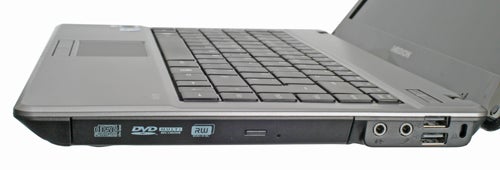
Connectivity is reasonable, with three USB ports, VGA, Gigabit Ethernet, a memory card reader, headphone and microphone jacks and a 34mm ExpressCard slot all included, but the lack of HDMI is another cost cutting measure. We can understand this omission on a cheap machine like this, but we’d always prefer to see it than not.
Always a concern on cheap laptops are the input devices; the keyboard and touchpad. Unfortunately, it’s with these that the E3211 really begins to falter, particularly the keyboard. From a distance it looks okay, but Medion commits that old sin of the Fn key sitting outside the left-Ctrl key, thus constantly interfering with shortcuts. It’s the keys themselves that are the real problem, though. Key actions feel soft and uneven, providing little by way of positive feedback. In comparison, the touchpad is okay, but its coarse texture only serves to enhance the cheap feel of this machine. 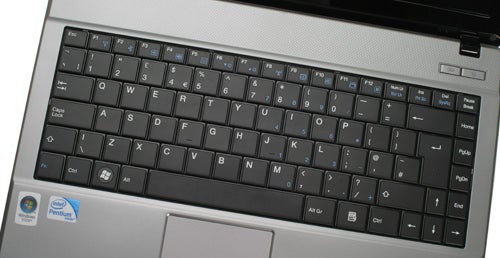
Another weakness is the integrated speakers. They’re very weak and tinny, though the Medion is hardly alone in this respect – Acer’s range is no more impressive. Likewise the display, which has a 1,366 x 768 native resolution, suffers from the usual poor viewing angles. On the plus side the display also has a non-reflective, matt finish, which is something we wish more laptops would adopt. Are we seeing a return to common sense? Probably not, but it’s nice to dream!
Looking at the performance charts reinforces the fact that, faster than Atom or not, the single-core Pentium is no Road Runner. Indeed, the Medion is even slower than the similarly-specified Acer Aspire 4810T-353, whose 1.4GHz processor had slightly more L2 Cache: 3MB vs. 2MB. More startling is how the Acer Ferrari One, which uses a dual-core AMD processor and is classed as a netbook, outperforms both quite comfortably. Of course you are punished with less battery life and a machine that’s both rather hot and noisy, neither of which you can accuse the Medion of being, but the performance difference is a good 25 per cent overall.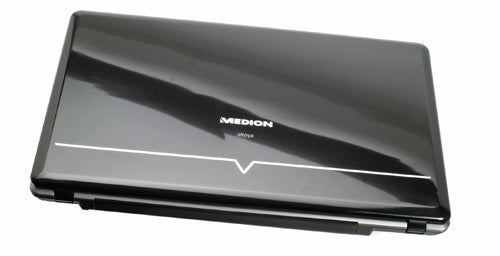
Subjectively the machine isn’t too rapid, either. It’s a fact not helped by the presence of Windows Vista Home Premium (a Windows 7 upgrade is available for 19.95 Euros), but nonetheless this system is best suited to basic tasks. Ultimately, while it is faster than an Atom-based netbook, it’s not by an order of magnitude.
Being a CULV laptop, battery life should be very good – it’s why this segment exists, after all. This is true of the E3211, though not to the same extent as Acer’s Timeline range. Utilising a six-cell, 47 Watt-hour battery, it managed a creditable four hours, 27 minutes in the Productivity segment of MobileMark 2007, while just shy of two and half hours of DVD playback allows for a long-ish film or a few TV episodes between trips to the wall socket.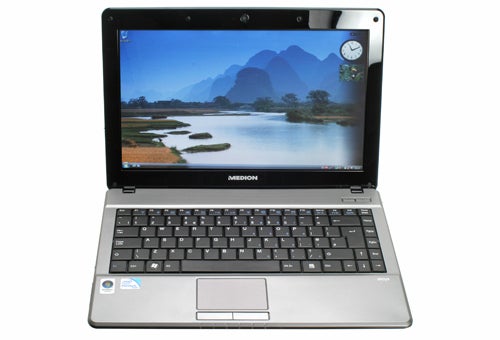
Verdict
The Medion Akoya E3211 is a bit of a Jekyll & Hyde product. On light side it’s cheap, well-featured, has decent battery life and offers an optical drive where competitors have none; on the dark it looks and feels like its price, has a poor keyboard and performance is lacklustre. If you’ve been looking at similar products but don’t want to sacrifice a disc spinner, it’s worth a punt, but we’d recommend waiting to see what else comes along.
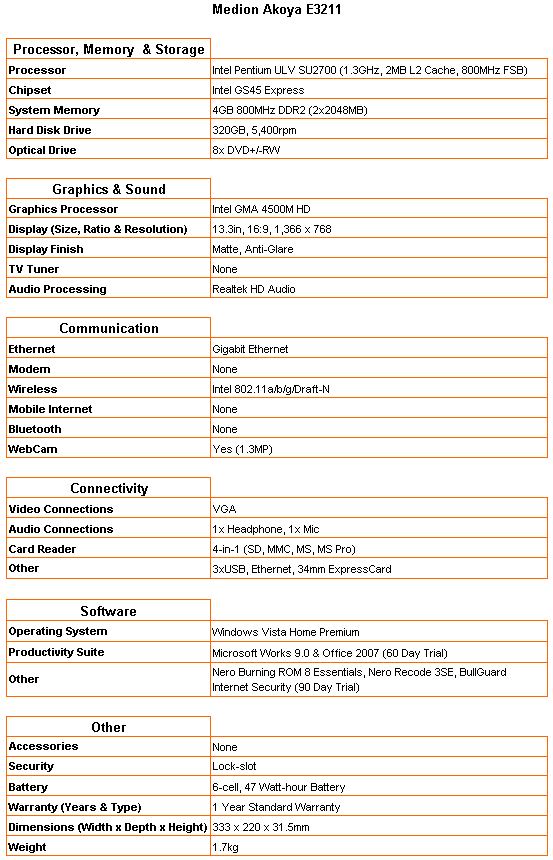
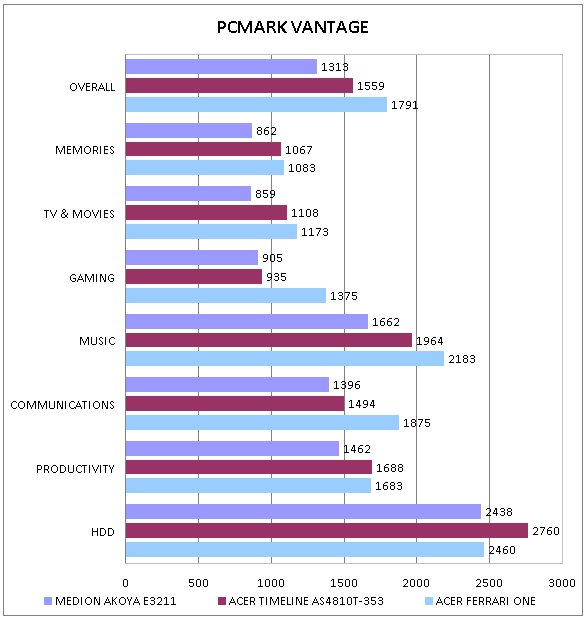
While the Medion is faster than your typical netbook, it’s beaten by Acer’s previous single-core CULV laptop and the dual-core AMD processor in the Acer Ferrari One. It does the job, but don’t expect a great deal of freedom.
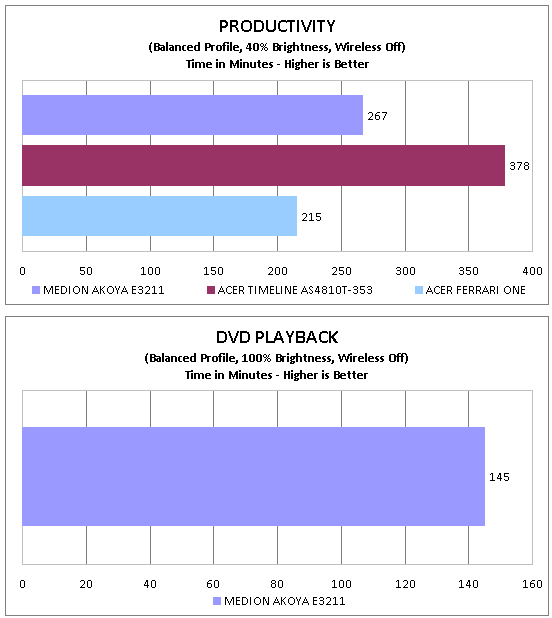
Battery life is very good, but not outstanding by the standards of CULV laptops, with the Acer comfortably outperforming the Medion.
How we test laptops
Unlike other sites, we test every laptop we review thoroughly over an extended period of time. We use industry standard tests to compare features properly. We’ll always tell you what we find. We never, ever, accept money to review a product.
Trusted Score
Score in detail
-
Performance 5
-
Design 5
-
Value 8
-
Features 8
-
Battery Life 8

